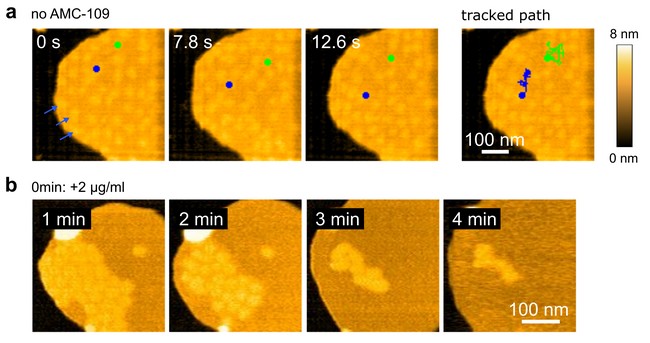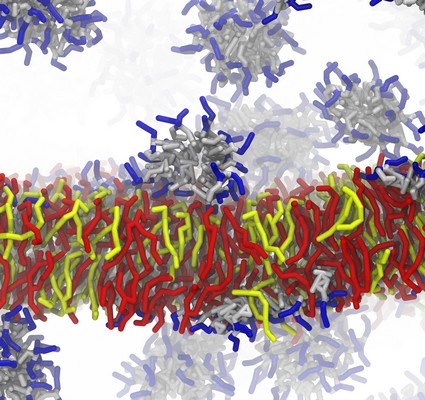New target for antibiotics promises treatment for resistant superbugs
The World Health Organization lists bacteria that are resistant to antibiotics as one of the top 10 global health threats. Therefore, researchers are looking for new antibiotics to counter this resistance. Adéla Melcrová, biophysicist at the University of Groningen, and her colleagues discovered that the relatively new antibiotic AMC-109 affects the cell membrane of bacteria by disordering its organization. This differs from most other antibiotics and could open up new directions for future treatment and drug development. The results were published in Nature Communications on 7 July.
FSE Science Newsroom | Charlotte Vlek
AMC-109, developed at the UiT Arctic University of Norway, has shown promising results in the lab as well as in clinical trials against the notoriously difficult-to-treat methicillin-resistant Staphylococcus aureus (MRSA). It will be tested on humans soon (phase 3 of clinical trials). However, it was not known exactly how AMC-109 works on bacteria. ‘I found it surprising that no one knew exactly how it worked,’ says Melcrová. ‘So, I decided to have a look at it.’

Many antibiotics operate by punching holes in the membrane of the bacterium, which forms a boundary between the inside and the outside of the bacterium. This membrane is vital to regulating what comes in and what stays out, as well as to building the protective cell wall around the bacterium. ‘The developers of the drug, who collaborated in this study, thought that AMC-109 makes holes in the membrane of the bacterium, just like other antibiotics,’ says Melcrová. But this is not what she found.
Disorganization leads to death
Melcrová took the membrane of Staphylococcus aureus, extracted for her by the University of Groningen Molecular Microbiology group. Melcrová herself is based in the Biophysics group of Professor Wouter Roos, where, as she explains, ‘we study biology with methods from physics.’ Together with her colleague Sourav Maity, Melcrová studied the bacterial membrane with a High-Speed Atomic Force Microscope (HS-AFM), which speedily taps the material with a tiny tip, measuring thickness and stiffness of the material.
What Melcrová and Maity saw with the HS-AFM were small areas of a higher membrane thickness, indicating some sort of structural organization. Upon adding AMC-109 to the membrane, these thicker areas clustered together and then dissolved. ‘A bit like an iceberg that melts: the material is still there, but the structure is gone,’ Melcrová says. ‘And apparently, the disruption of these areas is sufficient to lead to the death of the bacterium.’
(Text continues below the image)

Clumps: for once a good thing
In collaboration with the Molecular Dynamics group, Josef Melcr has built a simulation model of the interaction between the membrane and the antibiotic, using the Martini forcefield. Melcrová: ‘While the experiments show us what happens, a simulation allows us to interpret what we see.’ And what the simulation showed was that the AMC-109 forms small clumps. Subsequently, these clumps infiltrate the bacterial membrane.
‘Any doctor would tell you that aggregation is a bad thing,’ says Melcrová. ‘Several diseases are caused by aggregating proteins: Alzheimer’s disease, for instance. But in this case, it is a very good thing.’ On its own, AMC-109 would also attack human cells. But by clumping together, some properties are ‘hidden’ on the inside of the bunched-up AMC-109, making it safe for the human body.

Boosting other antibiotics
Now that the effect of AMC-109 on the membrane of bacteria is clearer, new possibilities for future drug development open up. ‘For instance,’ says Melcrová, ‘drugs could be developed that explicitly aim to disorganize the membrane structure.’ There is also evidence suggesting that the disorganization breaks down the resistance of the bacteria to old-fashioned antibiotics. ‘This is still a hypothesis,’ Melcrová explains, ‘but it could mean that a treatment with AMC-109 could potentially also boost the effect of a “classic” antibiotic.’
‘I am happy that this work is finally out,’ says Melcrová. ‘It took four long years of work. We went through a lot of stress, frustration, and arguments but we also enjoyed the great discoveries and putting the puzzle of this unique antibiotic action together. The fact that one of the collaborators, Josef Melcr, is also my husband meant that this project was always with me, even at home,’ says Melcrová with a smile.
Reference: Melcrová, A., Maity, S., Melcr, J., de Kok, N.A.W., Gabler, M., van der Eyden, J., Stensen, W., Svendsen, J.S.M., Driessen, A.J.M., Marrink, S.J., Roos, W.H. Lateral membrane organization as target of an antimicrobial peptidomimetic compound. Nature Communications, 7 July 2023.
Adéla Melcrová also blogs and tweets about her research endeavours.
| Last modified: | 03 October 2023 3.10 p.m. |
More news
-
13 May 2024
Trapping molecules
In his laboratory, physicist Steven Hoekstra is building an experimental set-up made of two parts: one that produces barium fluoride molecules, and a second part that traps the molecules and brings them to an almost complete standstill so they can...
-
29 April 2024
Tactile sensors
Every two weeks, UG Makers puts the spotlight on a researcher who has created something tangible, ranging from homemade measuring equipment for academic research to small or larger products that can change our daily lives. That is how UG...
-
16 April 2024
UG signs Barcelona Declaration on Open Research Information
In a significant stride toward advancing responsible research assessment and open science, the University of Groningen has officially signed the Barcelona Declaration on Open Research Information.

